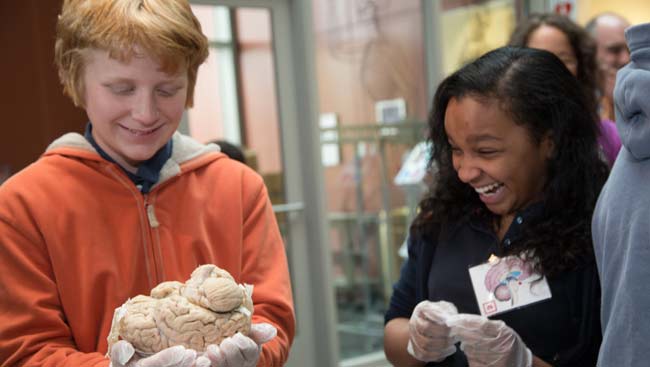
As our society focuses more on STEM education and research, it is important that scientists are willing and prepared to share our stories to further understanding and connection.
To learn more about public outreach, I decided to volunteer at two events in the Washington, DC, area: the Washington, DC regional Brain Bee competition and AAAS's Family Science Days.
These experiences gave me valuable insight into how best to prepare and interact with the public. Here is what I learned through them that could be applied in any outreach setting.
How to Prepare
Your work ahead of time will depend on the specific event and can range from brushing up on basic neuroscience concepts to being ready to greet people with a smile.
The Brain Bee is an annual competition for high school students that functions much like a spelling bee. The last student standing with the highest number of correct answers wins. To be as comfortable and useful as possible on the day of, I recommend you:
- Talk to the head judge before the competition starts to learn the rules.
- Familiarize yourself with the questions, which come from SfN’s BrainFacts, book ahead of time.
- Review basic neuroscience concepts such as gross neuroanatomy and functions of major areas to ensure you give a fair assessment of each answer.
AAAS Family Science Days took place along with the AAAS annual meeting in Washington, DC, where I worked at the SfN exhibit booth with two activity stations and a general information desk. To run a successful exhibit booth, we:
- Arrived early to visit each station, learn how the activities work, and run through them a few times with the other volunteers.
- Got feedback from colleagues and friends on our activities to ensure they ran smoothly and were easy for all ages to understand.
- Brought extra materials of paper-based activities, candy, and crafts supplies.
Interacting with the Public
The most challenging aspect of interacting with the public is turning complex ideas and concepts into intellectual morsels that are just right for your audience. These engagement tips can help:
- Know your audience. They may range from young children to older adults. I always ask a few questions about what they know so I can grasp their knowledge base.
- Explain and demonstrate concepts in the simplest terms possible. I often use analogies to relate difficult concepts to everyday life.
- Be flexible. When interacting with the public, especially children, anything can happen.
The most important thing to remember about any public outreach activity is that we are ultimately trying to share our knowledge and interest in science with others, even if it doesn’t go exactly as planned. Public outreach is a fun and rewarding experience, and just like research, it becomes a lot easier with time and practice.
Participating in these outreach events was an amazing opportunity and allowed me to hone my communication skills.








